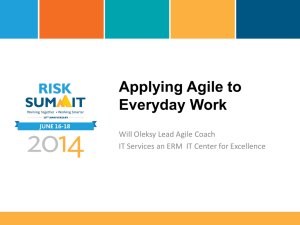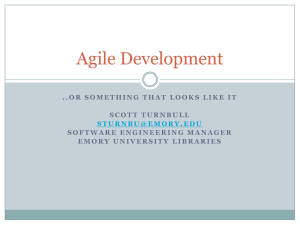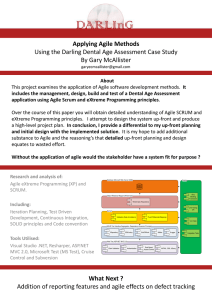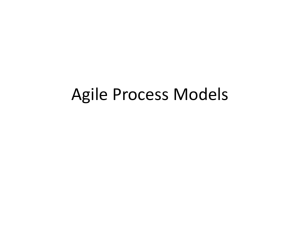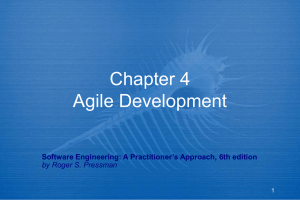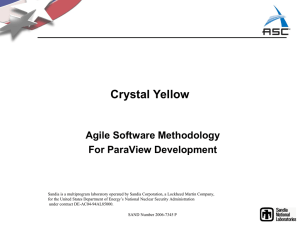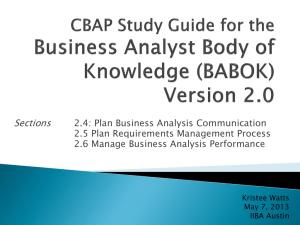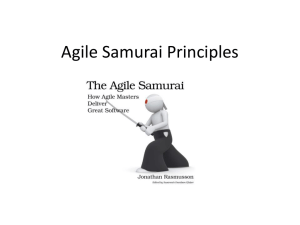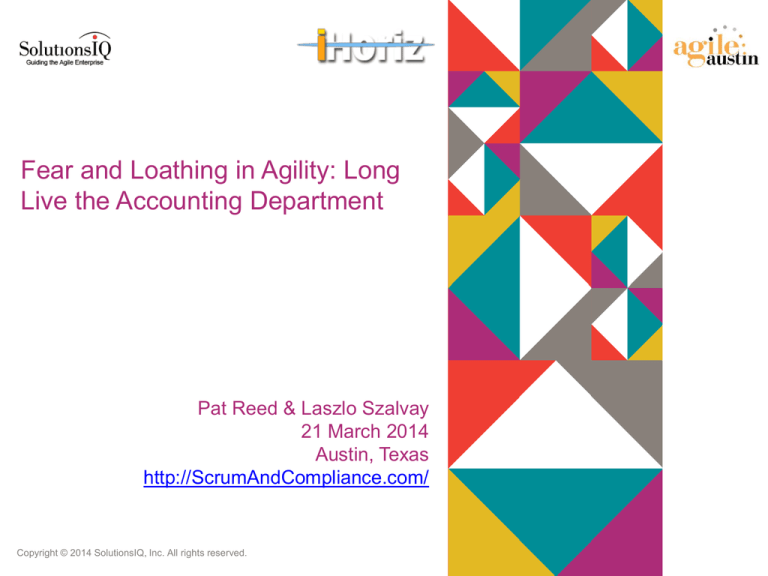
Fear and Loathing in Agility: Long
Live the Accounting Department
Pat Reed & Laszlo Szalvay
21 March 2014
Austin, Texas
http://ScrumAndCompliance.com/
Copyright © 2014 SolutionsIQ, Inc. All rights reserved.
To become a mainstream methodology, Agile had
to overcome many potential obstacles. The first
was geography…One of today’s most daunting
obstacles is compliance, often bringing
heavyweight documentation, required procedures
that are very waterfall-ish, complex approval
workflows, and complicated approval processes.
July 2011
Forrester Research, Inc.
“Compliance Is A Hurdle, Not A Barrier, To Agile”
Tom Grant, PhD
Agile Community of Practice
“It’s kind of fun to do the impossible”
About SolutionsIQ
•
Company operations embrace Agile
practices
•
>150 people working across the globe
•
Engagements are collaborations between
our consultants and clients
•
Change Management on a large scale
•
Embedded Agile practitioners work side-byside with client teams
•
Full Scrum teams deliver Agile software
compliance is complex
• Ever changing
• More scrutiny due to Sept 2008 crash and general
‘anger’ at Wall Street (e.g. Occupy Movement)
• Many faces, although for financial vertical Singapore is
emerging as a leader (strategic)
• Not familiar with internal corporate vernacular, culture, or
even software development
compliance has emerging leaders
• Singapore sees compliance as a strategic differentiator
and Singaporeans have taken a very taken a very hard
position within the banking industry. As such, they are
now seen
as the international standard.
• Complex set of cross-border rules that can be
contradictory, incomplete, or vague
• Have seen this in other industries (e.g. Postal)
• Customs is where the most senior people from DHL,
FedEx, UPS sit
agenda
1.problem statement
2.the solutions
3.closing
problem statement: mindsets & mental models
8
quotes from regulated industries
“
Agile is not just a method or a process, it’s a way of being. You don’t
do Agile. You are Agile. The FBI has arranged to loan their
ScrumMaster to other teams to get them trained. Increased
Transparency has kept stakeholders in sync. Further, stakeholders
would modify their expectations, based on the increased visibility of
the process.
Jack Israel, CTO FBI
With no significant bugs reported…operation nearly flawless – a
stunning and an unpredicted success. What are the implications for
failing IT programs across government?
Roger Baker, CIO VA
”
background
U.S. Securities and Exchange Commission (SEC)
requires that GAAP (Generally Accepted
Accounting Principles) be followed in financial
reporting by publicly traded companies. Currently,
the Financial Accounting Standards Board (FASB)
is the highest authority in establishing generally
accepted accounting principles for public and
private companies, as well as non-profit entities;
and the guidance on how to apply GAAP
principles has been written in language designed
around a waterfall software development
methodology.
relevant gaap principles/constraints
• Objectivity principle: the company financial
statements should be based on objective
evidence.
• Materiality principle: the significance of an
item should be considered when it is
reported.
• Consistency principle: The company uses
the same accounting principles and
methods from year to year (note:
referenced by documented policies)
• Conservatism principle: when choosing
between two solutions, the one that will be
least likely to overstate assets and income
should be picked
the cfo need to understand “the why”
Before an Agile initiative can
scale, an Agile accounting
practice needs to be
developed to enable CFO’s to
understand and leverage the
benefits of Agile software
development.
12
what’s the problem, man?
To ensure compliance, we
must interpret regulatory
guidelines through an
Agile Lens to consistently
estimate, allocate, track,
and report labor costs to
internal IT projects based
on project work done in
three specific phases:
Preliminary, Development,
and Post Implementation.
13
don’t end up a dead scrum master
How do we replicate the
Preliminary, Development,
and Post Implementation
phases within an Agile
context consistent with
both Agile and Accounting
Principles and Values….
without ending up a dead
ScrumMaster?
14
2
the solutions: break paradigms,
expand mental models and
create a common language,
culture and partnership
17
waterfall methodology
Effort
3 Months
Preliminary
Development
Time
Post Implementation
agile methodology
Time
Iteration 1
2
3
4
5
6
3 months
Effort
an agile approach. . .
Step 1: Paradigm shift: let’s suspend our knowledge
of the differences between Agile and
Waterfall…..and take a new look at the “waterfall
centric” project stage framework through an Agile
lens
Step 2: Adopt an Agile Project Stage Framework
and Test Case
Step 3: Standardize on a lightweight process to
capture evidence of management authorization
and commitment to project funding
Step 4: Apply and adapt this framework to our
organization
a new look at agile
5
Time
Iteration 1
2
3
4
3 months
What happens before Iteration 1 begins?
Effort
reduce the problem to simple rules
1. The nature of work performed in the
Preliminary and Post Implementation
phases is primarily Expense.
2. The nature of work in the Development
Phase determines whether it will be
Capitalized (if the work is critical to creating
the asset) or Expense (if the work is
basically overhead i.e. training, manual
data conversion, administrative)
22
can project labor can be capitalized?
• It is reasonably expected that the project will be completed and the software
will be used to perform the function intended.
• Beneficial use of a minimum duration of 3 years
• New or upgraded software functionality
• Estimated costs (excluding hardware and software costs) result in the
creation of a new asset of at least $100K.
• High probability that the project can be accomplished
• Preliminary project stage is completed
• Management, with the relevant authority, implicitly or explicitly authorizes and
commits to funding a computer software project and it is probable that the
project will be completed and the software will be used to perform the function
intended.
critical success factors to build an acceptance test
•
•
•
•
•
•
Simple
Defensible / Auditable
Consistent across divisions
Scalable
Sustainable
Easy to understand, interpret, implement,
administer
• Value and risk balanced
acceptance test scorecard
Does this solution clearly address the 3 stages of an IT project?
1.
2.
3.
Preliminary (expense)
Development (mostly capital except for administration,
overhead, training and data conversion costs)
Post Implementation (mostly expense)
Have we documented management authorization of funding?
Have we assessed probability that the project will be completed
and resulting software used to perform the function intended?
When do we define that the software is complete and ready for
it’s intended use?
Would this proposed solution provide a defensible, auditable,
scalable and sustainable solution?
Is it consistent with GAAP and FASB (SOP 98-1)?
expense versus capitalization
Inception:
Expense
Customer Evaluations
Quickstart
Inception Deck
Treatment
Design Storming
• Feature 1
Release N: Theme
• Feature 2
• Feature 3
R
Release
Backlog
• Story 1
Iteration 1
• Story 1
Iteration 2
• Story 3
• Story 2
• Story 3
• Story …
• Story 2
• Story 4
Capital
Iteration 3
• Story 5
• Story 6
• Story 7
Iteration …
• Story 8
• Story 9
• Story 10
Backlog
• Story 11
• Story 12
• Story …
26
agile capitalization
Costs can be Capitalized once the “Approval to Start” has been secured and end at the completion of
the Application Development stage when the asset is in production for customer use.
Preliminary Project
Project
Stages
Cost
allocation
Post
Implementation
Application Development
Inception
Treatment & Preproject tasks
Quick Start
Design Storming
It 0
It 1
It 2
It 3
It 4
…
72 Hrs
Expense
Capital and Expense
Expense Only
WhatHow
Capitalization Begins
Releases
It n
Release
Release
Capitalization Ends
Release
Release
Release
…
Final set of
stories
deployed.
Release
• The Preliminary Project Stage: “What“ (Ends In Inception at the beginning of Design Storming)
• The Development Stage: “How “ (Starts with Design Storming)
• The Post Implementation Stage: “When” (Begins 72 hours after the last production
implementation, when final user acceptance testing and Level 2 support or maintenance handoff
is complete)
3
closing: get involved
28
get involved
Join the conversation at
http://ScrumAndCompliance.com/
29
Thank you!
Pat Reed
preed@ihoriz.com
+1.650.515.2989
Laszlo Szalvay
lszalvay@solutionsiq.com
+1.971.506.7862
Copyright © 2014 SolutionsIQ, Inc. All rights reserved.



